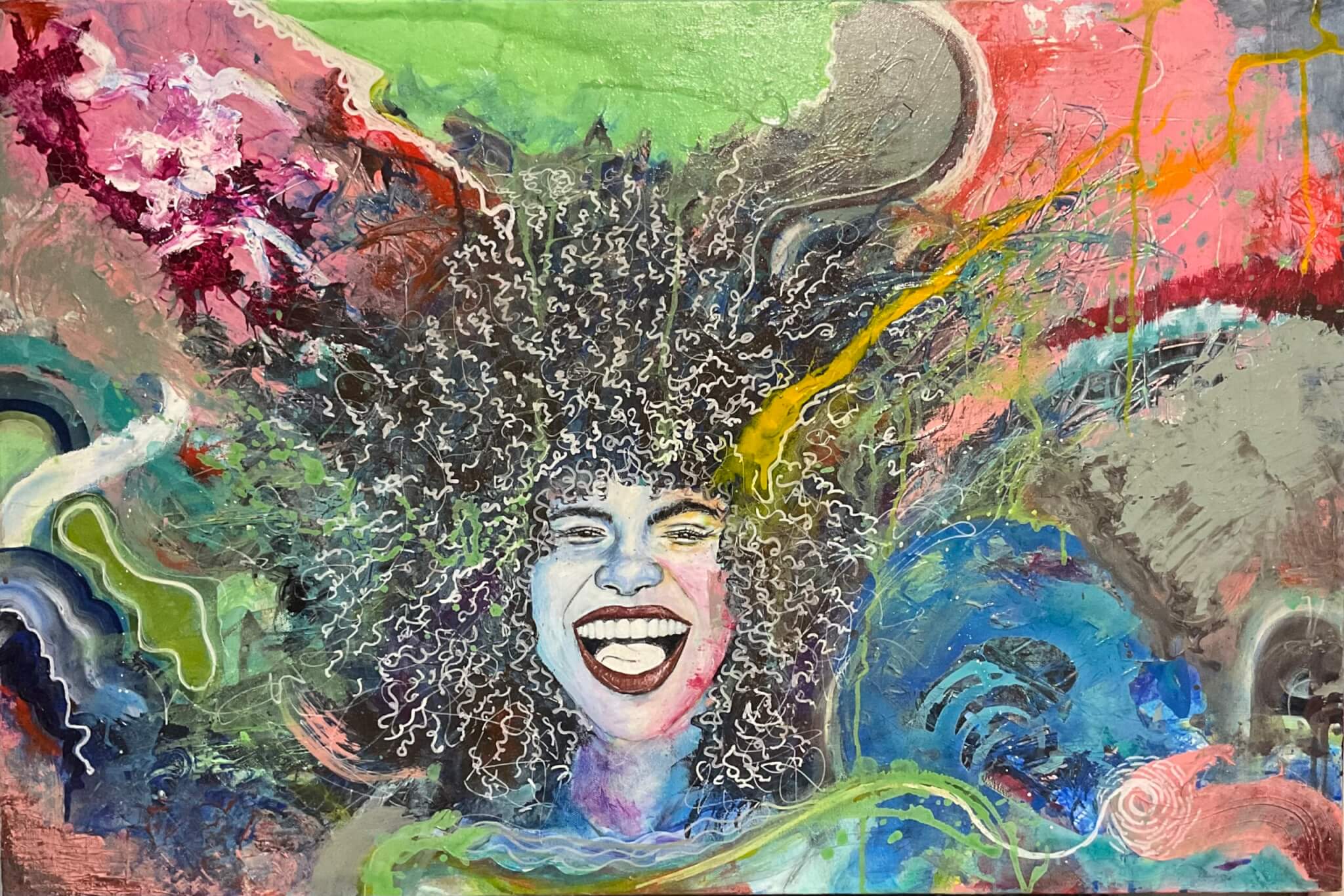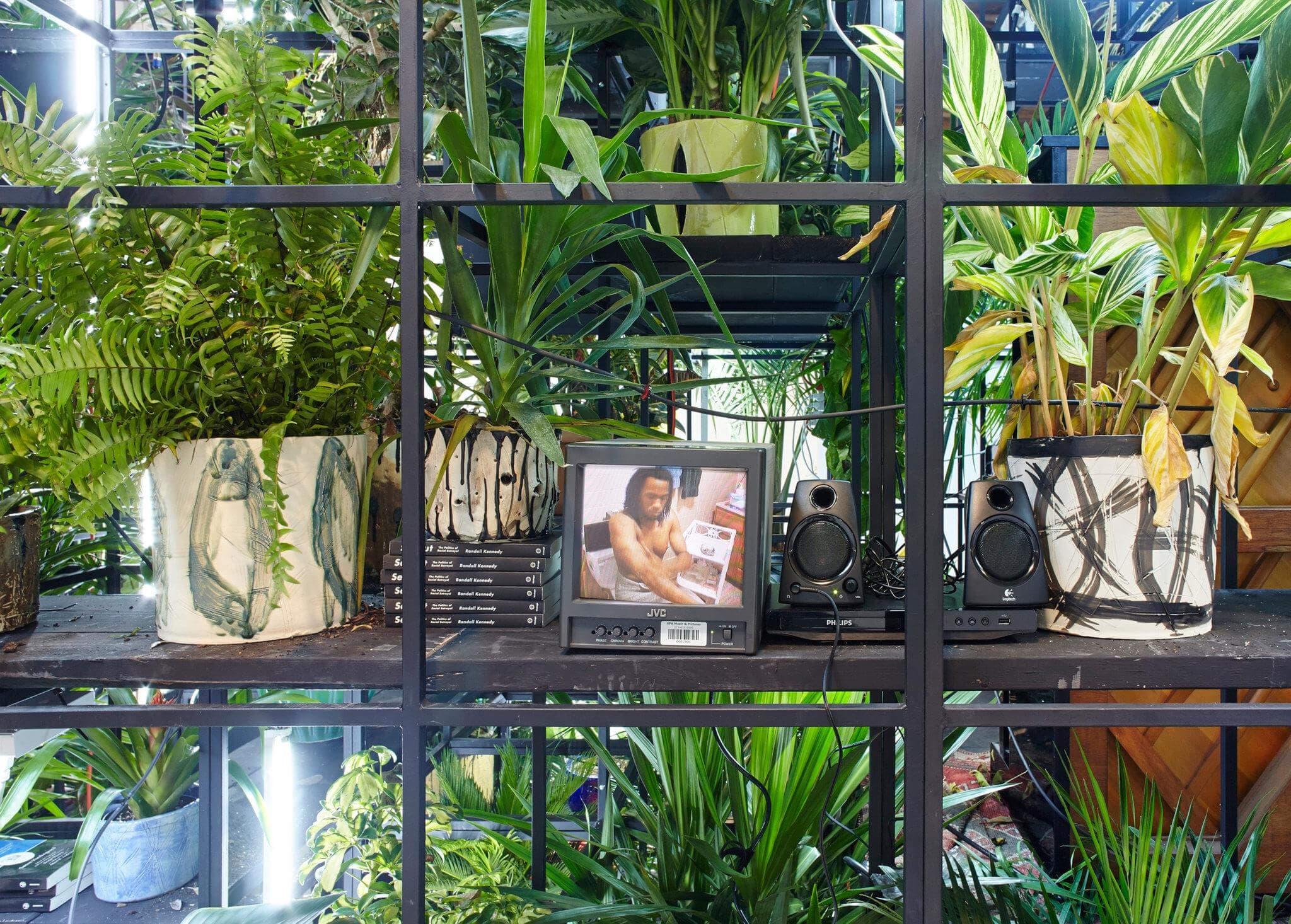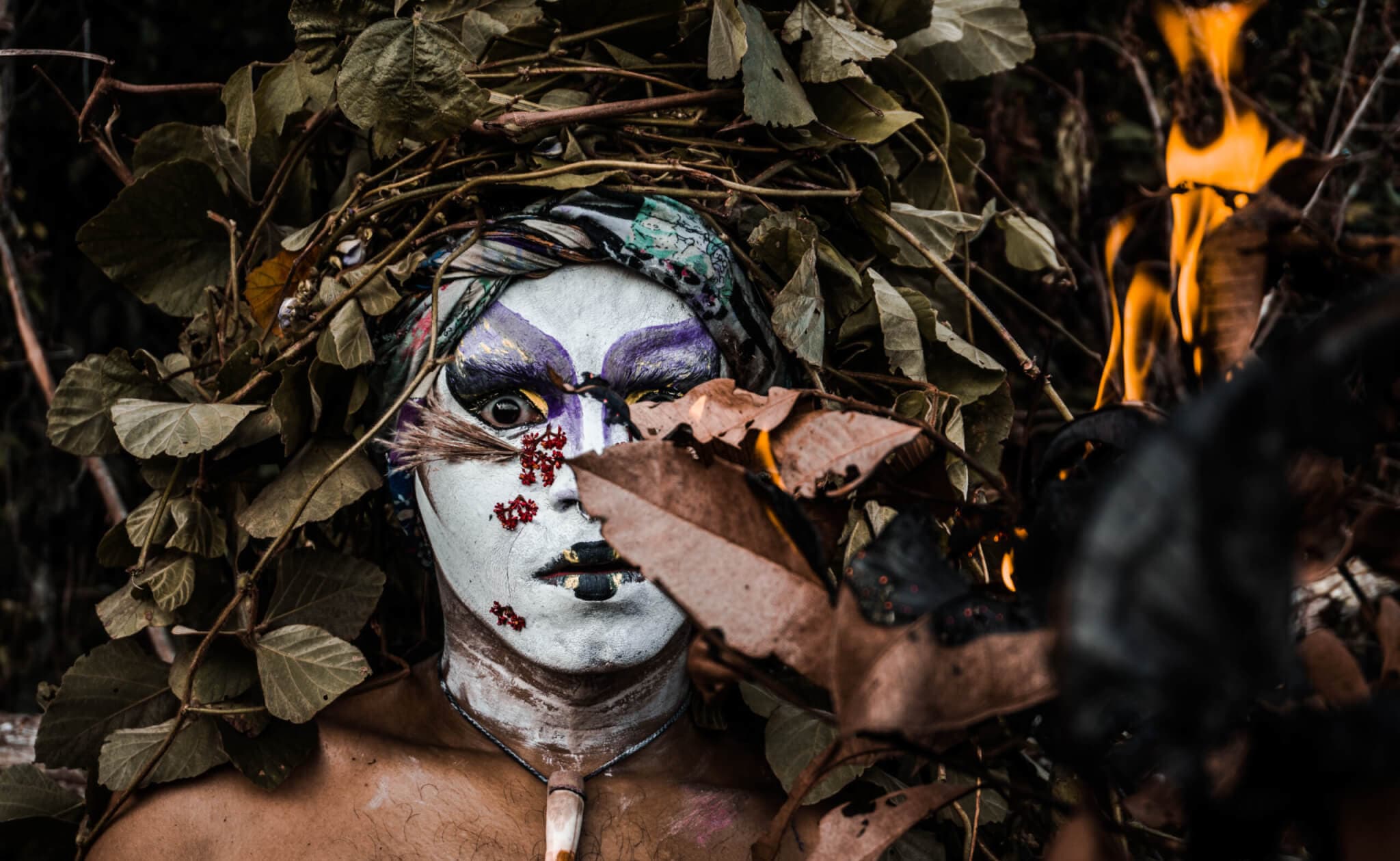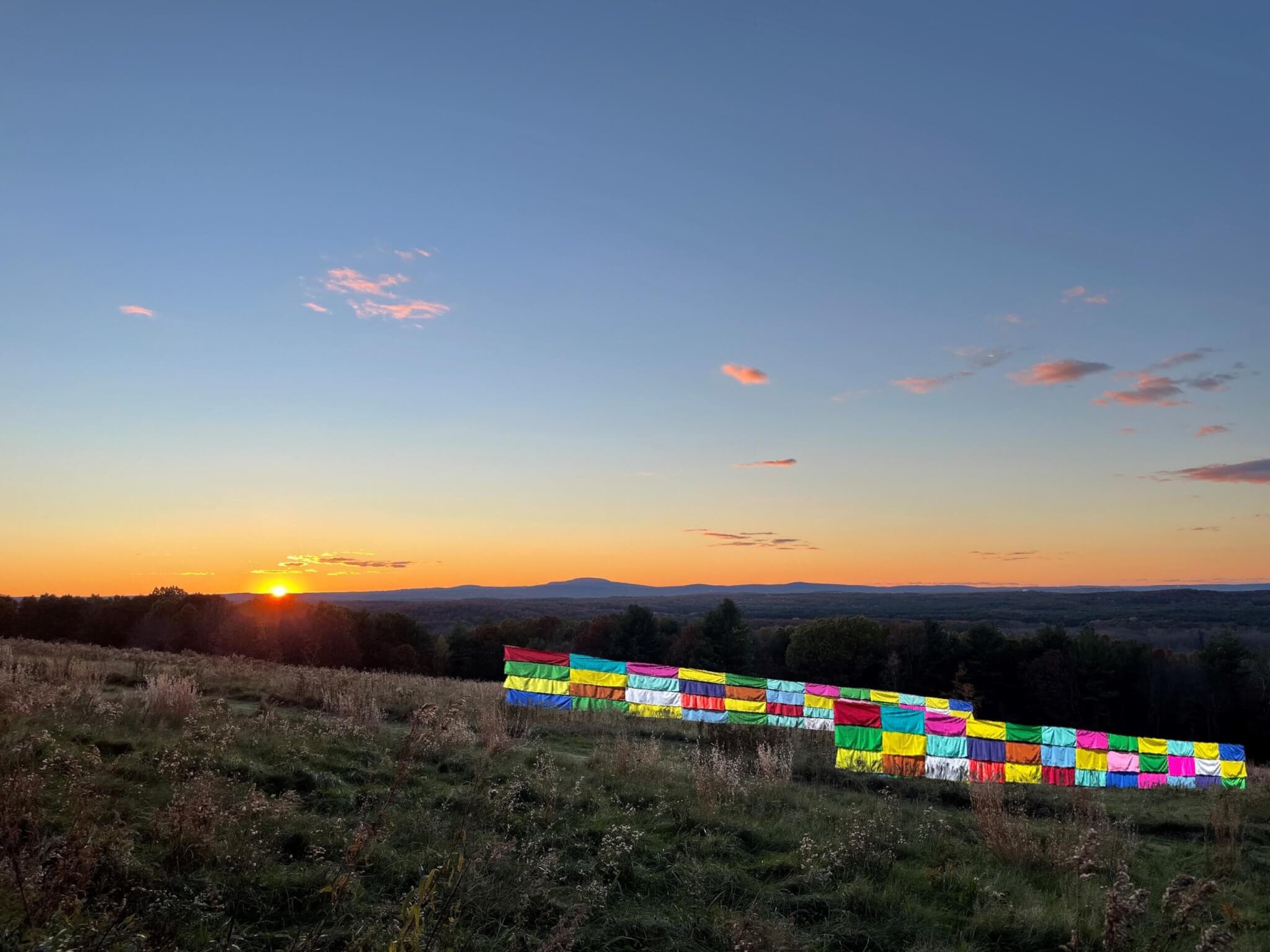Each summer, the BAR editors delight in putting on our travel guide hats as we scope out the daytrip-worthy exhibitions dotting New England. From plants and portraits to divahood and DIY, we’re excited about exhibitions that are enlivening museums and taking us to art spaces that double as watercraft (yes, you read that correctly). Whether you’re taking a train to Providence, a car to the Berkshires, or a walk across the Charles, these are the shows we’re excited about this summer—some close to home, others worth a day trip.

Installation view, “Scene,” Apartment 13, 2023. Courtesy the gallery.
Apartment 13 Gallery
100 Bowen St. #4E, Providence, Rhode Island
“Scene,” May 20–July 5, 2023
“Scene” at Apartment 13 Gallery in Providence is a salon-style exhibition featuring works by sixty-six different artists. In a statement posted on Instagram, the gallery writes, “There is no scene,” and further explains how the internet has created a decentralized free-for-all of art and visual culture. Perhaps scenes are more fleeting than they once were, less about location and more about happenstance or a micro-zeitgeist. “Scene” collects the pieces of an ever-fluctuating network, and beautiful moments emerge, like Rolf Nowotny’s monstrous couple DOLDRUM, the waxy, spiky, hairy miniature pair resting on a video monitor. Apartment 13 Gallery creates the conditions for audiences to learn about new artists, expand their roster, and make new connections—each individual’s scene co-existing in infinitude.
—Maya Rubio

Ani Jacsmile Cassion, Joy, 2023. Acrylic on canvas. 24″ x 36″. Photo courtesy of the artist.
WaterFire Arts Center
475 Valley St., Providence, Rhode Island
Providence Biennial for Contemporary Art, July 13–August 20, 2023
For its tenth exhibition, the Providence Biennial is debuting a new format that’s bringing two exciting shows by emerging curators—Melaine Ferdinand-King’s “Poiesis” and Joel Rosario Tapia’s “Remedy”—to the WaterFire Arts Center. Each show responds to the shared theme of “commemoration” in different ways, and together, they feature work by nearly fifty local artists (including Ani Jacsmile Cassion, whose work is pictured here). The programming kicks off with an opening reception that will include an intervention by Lilly Manycolors and a performance by Eastern Medicine Singers, plus beats by DJ Cam Bells on the former rubber factory’s roof deck. If you haven’t explored the city’s outsize art scene, consider this your chance to dive in.
—Jacqueline Houton

Installation view, “Prima Materia: The Periodic Table in Contemporary Art,” The Aldrich Contemporary Art Museum, February 5 to August 27, 2023. Photo by Jason Mandella.
The Aldrich Contemporary Art Museum
258 Main Street, Ridgefield, Connecticut
“Prima Materia: The Periodic Table in Contemporary Art,” February 5–August 27, 2023
My most prominent memory of the periodic table takes place in eighth grade chemistry class, where I am fighting down a wave of boredom-panic at the thought of engaging with 118 tiny coded tiles, rendered in antiseptic colors, punctuated by formulas, each more nonsensical than the last. Then, and for many years after, the elements called to mind sterile procedure and rote memorization, bearing no association with their murky and esoteric past. Ancient theologies, secret alchemical lairs, the search for immortality, the grasping of divine truths and power and beauty: none of this could seem further from my middle-school science class, but it is indeed the path taken to our contemporary understanding of the periodic table, a trajectory illustrated in “Prima Materia: The Periodic Table in Contemporary Art” at the Aldrich Contemporary Art Museum. This show pairs a contemporary art object with the element that inspired or comprises it, showcasing works from artists like Matthew Barney and Beverly Pepper—and an entire alchemical shack by Robert Williams—reminding us that with art, elements may not transmute into gold, but they offer us something much more precious.
—Jessica Shearer

Andrius Alvarez-Backus, Twin Regenerations, 2023, charred pine, tambo (tiger grass), 30″ x 52″ x 7″. Image courtesy of Fitchburg Art Museum.
Fitchburg Art Museum
185 Elm Street, Fitchburg, Massachusetts “
Andrius Alvarez-Backus: Desastre,” June 23–August 27, 2023
“Desastre” will be the first solo museum exhibition for Andrius Alvarez-Backus, and it promises to be an exciting one. Alvarez-Backus was last summer’s First Prize winner in the Fitchburg’s 86th Regional Exhibition of Art & Craft; for “Desastre,” the artist will draw upon his Filipino heritage to examine the complex and intertwining themes of colonialism and identity through a deft manipulation and layering of everyday, natural, and decorative objects. Alvarez-Backus’s curious compositions signal feelings of precariousness and instability about the world around us, yet his commitment to detail and form speaks volumes about this emerging artist.
—Karolina Hać

Morgan Bassichis, Quarantunes, April 4, 2020. Instagram video, 59 seconds. Courtesy the artist
Carpenter Center for Visual Arts at Harvard
24 Quincy St, Cambridge, Massachusetts
“Morgan Bassichis: More Little Ditties,” June 30–September 3, 2023
With no disrespect for another queer comedian who has entered hallowed museum halls in recent weeks, I’m far more excited to revel in Morgan Bassichis’s “little ditties” than I am in Hannah Gadsby’s Picasso takedown. At the Carpenter Center, it’s hard to say exactly what viewers can expect from the musician-performer-writer-comedian (unexpectedness is essential to their charm), but I can promise many hearty laughs. I became acquainted with Bassichis’s humor and politics via Instagram when their Quarantunes offered comforting scores in the form of minute-long videos to the mundanity and uncertainty of the “early Covid days.”
Like any good comedian, the subject of the Newton-born artist’s work extends outward from Bassichis’s own identities and humorous insecurities: “What if no one comes to my anti zionist bat mitzvah show” is indeed a sing-songy tune that got stuck in my head.
Am I making you afraid that you might have missed out on years of Bassichis’s delightful ditties because you weren’t following them on Instagram? Fear not. Their first institutional solo exhibition will feature documentation of past performances including More Protest Songs! (2017) and Quarantunes (2020) as well as the debut of a new book and music video that, like most of the artist’s oeuvre, will merge the personal and the political with wit and whimsy. “More Little Ditties” will then travel to Institute of Contemporary Art at Virginia Commonwealth University, which was a co-organizer of this exhibition, in the fall.
—Jameson Johnson

Exterior of the 100 Lagoon Pond houseboat after being transformed into a gallery. Photo courtesy of Marion Wilson.
100 Lagoon Pond: Floating Gallery
Vineyard Haven, Martha’s Vineyard, Massachusetts
“Please Don’t Feed The Birds,” July 7–September 10, 2023
Perched at the end of a boat ramp in a Vineyard Haven harbor, 100 Lagoon Pond is the latest project by artist Marion Wilson, who has repurposed an all-wooden houseboat into a contemplative site for art and ecologies. The inaugural exhibition, “Please Don’t Feed the Birds,” features an impressive and eclectic smattering of artworks by Melissa Friedling, Lyle Ashton Harris, Karsen Heagle, Sheida Soleimani, and Marion Wilson. Though varying in medium, each artwork centers birds as collaborators and interlocutors for considering everything from queer identities to pollution and extinction. Out on the gallery’s back deck, guests will be level with all the wildlife that call the marshy harbor their home—yet another reminder of our ecological interconnectedness.
—Jameson Johnson

Rashid Johnson, Antoine’s Organ, 2016. Black steel, grow lights, plants, wood, shea butter, books, monitors, rugs, piano. © Rashid Johnson. Martin Parsekian photo © Hauser & Wirth.
Isabella Stewart Gardner Museum
25 Evans Way, Boston, Massachusetts
“Presence of Plants in Contemporary Art,” June 22–September 17, 2023
Plant life has always been (quite literally) central at the Gardner Museum, where the lush courtyard blooms even in the depths of winter; now this exhibition showcasing eight international artists has greenery sprouting up throughout the special exhibition spaces. On the museum’s façade, Natalie Jeremijenko’s suspended plant installation The Declaration of Interdependence will weave the Gardner’s signature nasturtiums into a web of interspecies relationships, while in the Fenway Gallery, Zheng Bo’s video Pteridophilia captures encounters between queer people and queer plants (namely ferns, which reproduce with spores, not seeds). And the Hostetter Gallery will host everything from Heather Ackroyd and Dan Harvey’s photographic portraits grown in grass to Rashid Johnson’s massive multimedia installation Antoine’s Organ, a steel structure bearing books, shea butter sculptures, video monitors, and 285 potted plants whose foliage nearly conceals a working piano that’ll be played daily by Berklee jazz musicians. The range of approaches and themes might just leave you thinking that plants are nearly as versatile a medium as paint.
—Jacqueline Houton

UÝRA, Série A Última Floresta Fogo, 2018, digital print. Courtesy of the artist. Photo by Matheus Belém.
Currier Museum of Art
150 Ash Street, Manchester, New Hampshire
“The Living Forest: UÝRA,” May 11–September 24, 2023
With “The Living Forest: UÝRA,” Manchester’s Currier Museum invites you into a world that is at once expansively universal and intensely private, that of Brazil-based trans-Indigenous artist and biologist UÝRA. With rich, striking photographs and video excerpts of the artist’s public and private performances, the exhibition offers a close look at a figure that defies easy categorization: Amazonian guardian-empath, walking-tree, two-spirit human-god, the list goes on. With tendrils of soil from an opening performance branching across the floor and the artist’s piercing gaze emitting a wild, shamanistic knowing from the walls and screens, “This Living Forest” is an immersive and cohesive dive into UÝRA’s long practice of personifying humanity’s enmeshed dependence on an abused climate, yet still captures the harmonious dichotomy of our relationships to gender and the natural world that is encapsulated better in the artist’s ancestral tongue—Tupi—which is populated with words that elegantly articulate concepts my own modern American English has to trippingly hyphenate. Here, and throughout the show, we find what UÝRA knows us all to be: composed of and made resplendent by the totality of our environmental, bodily, and spiritual ecosystems.
—Jessica Shearer

Artist E. Jane in their exhibition “Drenched in Light.” Courtesy Museum of Fine Arts, Boston.
Museum of Fine Arts, Boston
465 Huntington Avenue, Boston, Massachusetts
“E. Jane: Drenched in Light,” May 6–September 24, 2023
In “Drenched in Light,” E. Jane stages Black divas in dazzling purple light. As MFA Boston’s latest artist-in-residence, E. Jane presents their first solo museum show with an interdisciplinary query into the figure of the Black diva, archiving moments from greats like Diahann Carroll, Jennifer Holliday, Beyoncé, and Bessie Smith. Jane’s video essay LetMEbeaWomanTM.mp4 (2022) collages scenes of Black women figure skating, accepting Tonys and Emmys, as avatars, in a meadow of flowers, the words “A WOMAN™” overlaid at times. Questions emerge around gender performance, self-empowerment, and how cultural achievement operates for Black women. Guests can collect a free zine designed by E. Jane, which includes an excerpt from Zora Neale Hurston’s 1924 short story “Drenched in Light” and words on divahood.
—Maya Rubio

Michelle Hartney, Anarcha, 2014. Mixed-media sculpture (diptych): grosgrain ribbon, metallic embroidery floss, vintage obstetrics text. Dimensions variable. Photo courtesy of the artist and the Hutchins Center for African and African American Research, Harvard University.
The Neil L. & Angelica Zander Rudenstine Gallery at the Hutchins Center
104 Mount Auburn Street, Floor 3R, Cambridge, Massachusetts
“Call and Response: A Narrative of Reverence to Our Foremothers in Gynecology,” March 3–October 31, 2023
In 2019, the Resilient Sisterhood Project commissioned Jules Arthur to paint Lucy, Betsey, and Anarcha. Dr. James Marion Sims enslaved and violently experimented on these Black women in the mid-nineteenth century, and his findings led to modern gynecology. These women have remained faceless and voiceless in contemporary medical discourse and popular memory. In collaboration with Curator Dell M. Hamilton and the Hutchins Center for African & African American Research at Harvard, these paintings are now on view alongside newly commissioned works by Arthur, as well as a variety of other artists who center those three women.
Some of Arthur’s mixed-media paintings place their gazing faces near historical documents and texts, while others portray them among resistance movements in their honor. In A Bond of Sisterhood (2019), we can imagine an interior life of the three women as Arthur depicts them caring for each other after what was likely another one of Sims’s experiments. On another wall, Michelle Hartney’s diptychs include vintage obstetrics texts next to the names of the three women, which she embroidered with enlarged calligraphy. Theater stills, sculptures, photography, and other historical materials are also on display.
This exhibition confronts the history of the United States—and global—health systems that continue to harm Black women while also interrupting archives that silence and erase them. In “Call and Response,” artists and activists see Betsey, Lucy, Anarcha, and countless other Black women, and they talk back.
—Niara Simone Hightower

Carolee Schneemann, Eye/Body #5, 1963/1973. Helen M. Danforth Acquisition Fund. Courtesy RISD Museum.
Rhode Island School of Design Museum
20 North Main Street, Providence, Rhode Island
“The Performative Self-Portrait,” May 13–November 12, 2023
In the era of selfies, we see more self-portraits now than ever. The generative nature in taking these images and how the self is represented is what “The Performative Self-Portrait” surveys. Working in photography, the artists use the camera as an extension of themselves to present ideas around identity, explore their bodies, and ultimately confront the viewer. They implore honest and deceptive, tender and combative strategies to direct our gaze. Laura Aguilar uses her nudity and the size of her body to fill the frame and emphasize her own discomfort with self-image. In 12 Lauras she is slipping in and out of the frame. Her gaze only rarely meets the viewer with her eyes often wondering elsewhere. By contrast, Carolee Schneemann uses the power of her body through sexuality. She lays back confidently, her arms behind her head give a full view of her body, with bedroom eyes looking up to meet the viewer. With works dating from 1930 to today by more than two dozen artists—from Robert Mapplethorpe and Cindy Sherman to Andre Bradley and Jess T. Dugan—“The Performance Self-Portrait” is an encompassing genre exhibition.
—Kaitlyn Ovett Clark

Gio Swaby, My Hands Are Clean 4, 2017. Thread and fabric appliqué on canvas. Courtesy of Claire Oliver & Ian Rubinstein.
Peabody Essex Museum
161 Essex Street, Salem, Massachusetts
“Gio Swaby: Fresh Up,” August 12–November 26, 2023
Gio Swaby uses embroidery and fabric collages to create vast portraits of Black women and their personal style. Though the resulting portraits might not suggest it, Swaby’s work begins by inviting her close friends to photoshoots. While behind the camera, she attends to when her subjects appear the most confident and at ease in order to capture their evocative silhouettes. From those photographed moments, the life-size portraits emerge rendered in threads and colorful fabrics. “Fresh Up,” the artist’s first solo museum exhibition, includes works from 2017 to 2021. Co-organized by the Museum of Fine Arts, St. Petersburg and Art Institute of Chicago, the show soon arrives at its final destination in the North Shore.
Some of Swaby’s serial works include intricately embroidered portraits that outline facial features and clothing, while in others, Swaby relies on vibrantly patterned textiles to fill-in her subject’s visage. Through this abstraction, the lines between body and fabric blur, and the woman blooms. While “Fresh Up” opens in Salem this August, I was delighted to see some of Swaby’s newer portraits earlier this month in Harlem at Claire Oliver & Ian Rubinstein Gallery where the artist is represented.
Where threads dangle from Swaby’s reversed canvases, her Black women subjects reach beyond the space the portraits inhabit. While loose threads might be considered flaws in some contexts, here they lend depth and haptic pleasure to Swaby’s exquisite, affecting work.
—Niara Simone Hightower

Rachel Hayes, “The Edge of Becoming,” 2023. Courtesy of Fruitlands Museum.
Fruitlands Museum
102 Prospect Hill Road, Harvard, Massachusetts
“PLATFORM 31: Rachel Hayes, The Edge of Becoming,” June 21, 2023–April 1, 2024
Earlier this year, the Fruitlands Museum debuted “Rachel Hayes: Transcending Space” in its entrance and main gallery (this show will be on view through March 2024). The exhibition features Hayes’s mesmerizing large-scale, color-block hangings. Now, Hayes is taking things outside—“The Edge of Becoming” promises a new way to interact with the Oklahoma-based artist’s site-responsive textiles as this work flutters along the hillside on the Fruitlands’s expansive bucolic landscape. Combining elements of craft, sculpture, architecture, and land art, “The Edge of Becoming” promises a unique opportunity to connect with and reflect on one’s relationship to the landscape.
—Karolina Hać

Elle Pérez, Belt, 2020/2021, Archival pigment print, 35″ × 26 1/4″ (88.90 × 66.68 cm). Courtesy of the artist and 47 Canal, New York.
Mass MoCA
1040 Mass MoCA Way, North Adams, Massachusetts
“Elle Pérez: Intimacies,” July 22, 2023–TBD
Exploring the gaze, voyeurism, and intimacy in figurative work is nothing new in art history. Artists have long explored the play between subject and audience, often highlighting the role of power—the idea that in a sincere moment of intimacy, you are vulnerable, you are not in control. Photographer Elle Pérez uses their viewpoint to flip this narrative, showing strength in intimacy. One of the communities they work within are queer folks, people who are vulnerable in their daily lives. Pérez narrows the scope of the gaze and pinpoints what intimacy can look like and how it can be seen. Closeness can often be conflated with romance or misconstrued as an experience shared only by lovers. But intimacy can exist between friends, family—inherited or chosen—a key truth that queer portraiture displays. Pérez is acutely aware of the power in depicting this; they build meaningful relationships in order to take photos that show an intimate touch from artist to subject, which carries over to the viewer. Pérez creates deep trust that gives the viewer an earnest opportunity to see the person in the image. In these ways and more, Elle Pérez: Intimacies is a love note to the communities they work with.
—Kaitlyn Ovett Clark
Kaitlyn Ovett Clark is managing editor for Boston Art Review and the exhibitions and public programs manager at the Tufts University Art Galleries at the SMFA.
Karolina Hać is an editor at Boston Art Review and head of marketing at Höweler+Yoon Architecture, LLP.
Niara Hightower is editorial assistant at Boston Art Review.
Jacqueline Houton is senior editor at Boston Art Review and a copyeditor at Candlewick Press.
Jameson Johnson is editor-in-chief at Boston Art Review and marketing and development manager at MIT List Visual Arts Center.
Maya Rubio is an independent curator and an editor at Boston Art Review.
Jessica Shearer is a senior editor at Boston Art Review and director of communications and user experience at the Boston College Center for Corporate Citizenship.















